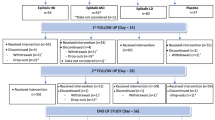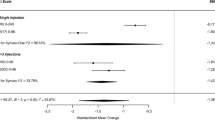Abstract
Objective
Twice-daily flavocoxid, a cyclooxygenase and 5-lipoxygenase inhibitor with potent antioxidant activity of botanical origin, was evaluated for 12 weeks in a randomized, double-blind, active-comparator study against naproxen in 220 subjects with moderate-severe osteoarthritis (OA) of the knee. As previously reported, both groups noted a significant reduction in the signs and symptoms of OA with no detectable differences in efficacy between the groups when the entire intent-to-treat population was considered. This post-hoc analysis compares the efficacy of flavocoxid to naproxen in different subsets of patients, specifically those related to age, gender, and disease severity as reported at baseline for individual response parameters.
Methods
In the original randomized, double-blind study, 220 subjects were assigned to receive either flavocoxid (500 mg twice daily) or naproxen (500 mg twice daily) for 12 weeks. In this subgroup analysis, primary outcome measures including the Western Ontario and McMaster Universities OA index and subscales, timed walk, and secondary efficacy variables, including investigator global assessment for disease and global response to treatment, subject visual analog scale for discomfort, overall disease activity, global response to treatment, index joint tenderness and mobility, were evaluated for differing trends between the study groups.
Results
Subset analyses revealed some statistically significant differences and some notable trends in favor of the flavocoxid group. These trends became stronger the longer the subjects continued on therapy. These observations were specifically noted in older subjects (>60 years), males and in subjects with milder disease, particularly those with lower subject global assessment of disease activity and investigator global assessment for disease and faster walking times at baseline.
Conclusions
Initial analysis of the entire intent-to-treat population revealed that flavocoxid was as effective as naproxen in managing the signs and symptoms of OA of the knee. Detailed analyses of subject subsets demonstrated distinct trends in favor of flavocoxid for specific groups of subjects.
Similar content being viewed by others
References
Lozada CJ, Altman RD. Management of osteoarthritis. In: Koopman WJ, ed. Arthritis and Allied Conditions. Baltimore, MD: Lippincott, Williams and Wilkins; 2001:2246–2263.
Salaffi F, Carotti M, Stancati A, Grassi W. Health-related quality of life in older adults with symptomatic hip and knee osteoarthritis: a comparison with matched healthy controls. Aging Clin Exp Res. 2005;17:255–263.
Sale JE, Gignac M, Hawker G. The relationship between disease symptoms, life events, coping and treatment, and depression among older adults with osteoarthritis. J Rheumatol. 2008;35:335–342.
Ethgen O, Vanparijs P, Delhalle S, Rosant S, Bruyere O, Reginster JY. Social support and health-related quality of life in hip and knee osteoarthritis. Qual Life Res. 2004;13:321–330.
Jinks C, Jordan K, Croft P. Osteoarthritis as a public health problem: the impact of developing knee pain on physical function in adults living in the community: (KNEST 3). Rheumatology (Oxford). 2007;46:877–881.
Burnett BP, Levy R, Cole BJ. Metabolic mechanisms in the pathogenesis of osteoarthritis. A review. J Knee Surgery. 2006;19:191–197.
Altavilla D, Squadrito F, Bitto A, et al. Flavocoxid, a dual inhibitor of cyclooxygenase and 5-lipoxygenase, blunts pro-inflammatory phenotype activation in endotoxin stimulated macrophages. Br J Pharmacol. 2009;157:1410–1418.
Burnett BP, Jia Q, Zhao Y, Levy RM. A medicinal extract of Scutellaria baicalensis and Acacia catechu acts as a dual inhibitor of cyclooxygenase and 5-lipoxygenase to reduce inflammation. J Med. Foods. 2007;10:442–451.
Yimam M, Zhao Y, Maa W, Jia Q, Do SG, Shin JH. 90-Day oral toxicity study of UP446, a combination of defined extracts of Scutellaria baicalensis and Acacia catechu, in rats. Food Chem Toxicol. 2010;48:1202–1209.
Messina S, Bitto A, Aguennouz M, et al. Flavocoxid counteracts muscle necrosis and improves functional properties in mdx mice: a comparison study with methylprednisolone. Exp. Neurol. 2009;220:349–58.
Burnett BP, Pillai L, Levy RM, editors. Flavocoxid, a natural novel flavonoid-based anti-inflammatory with a broad mechanism of action provides safe and effective inflammatory management of disease. Phoenix, AZ: Society for Biomolecular Science; 2010;11–15.
Burnett BP, Silva S, Mesches MH, Jia Q. Safety evaluation of a combination, defined extract of Scutellaria baicalensis and Acacia catechu. J Food Biochem. 2007;31:797–825.
Levy RM, Khokhlov A, Kopenkin S, et al. Efficacy and safety of flavocoxid, a novel therapeutic, compared with naproxen: a randomized multicenter controlled trial in subjects with osteoarthritis of the knee. Adv Ther. 2010. [Epub ahead of print].
Shapiro SS, Wilk MB. An analysis of variance test for normality (complete samples). Biometrika. 1965;52:591–611.
No authors listed. COX-2 Selective (includes Bextra, Celebrex, and Vioxx) and Non-Selective Non-Steroidal Anti-Inflammatory Drugs (NSAIDs). Available at: http://www.fda.gov/cder/drug/infopage/COX2/default.htm. Last accessed October 11, 2010.
Griffin MR, Piper JM, Daugherty JR, Snowden M, Ray WA. Nonsteroidal anti-inflammatory drug use and increased risk for peptic ulcer disease in elderly persons. Ann Intern Med. 1991;114:257–263.
Gurwitz JH, Avorn J, Ross-Degnan D, Lipsitz LA. Nonsteroidal anti-inflammatory drug-associated azotemia in the very old. JAMA. 1990;264:471–475.
Dieppe PA, Lohmander LS. Pathogenesis and management of pain in osteoarthritis. Lancet. 2005;365:965–973.
Walker-Bone K, Javaid K, Arden N, Cooper C. Regular review: medical management of osteoarthritis. BMJ. 2000;321:936–940.
Felson DT, Lawrence RC, Dieppe PA, et al. Osteoarthritis: new insights. Part 1: the disease and its risk factors. Ann Intern Med. 2000;133:635–646.
Felson DT, Lawrence RC, Hochberg MC, et al. Osteoarthritis: new insights. Part 2: treatment approaches. Ann Intern Med. 2000;133:726–737.
Fiorani M, Accorsi A, Cantoni O. Human red blood cells as a natural flavonoid reservoir. Free Radical Res. 2003;37:1331–1338.
Naftalin RJ, Afzal I, Cunningham P, et al. Interactions of androgens, green tea catechins and the antiandrogen flutamide with the external glucose-binding site of the human erythrocyte glucose transporter GLUT1. Br J Pharmacol. 2003;140:487–499.
Fiorani M, Accorsi A, Cantoni O. Human red blood cells as a natural flavonoid reservoir. Free Radic Res. 2003;37:1331–1338.
Author information
Authors and Affiliations
Corresponding author
Rights and permissions
About this article
Cite this article
Levy, R., Khokhlov, A., Kopenkin, S. et al. Efficacy and safety of flavocoxid compared with naproxen in subjects with osteoarthritis of the knee— a subset analysis. Adv Therapy 27, 953–962 (2010). https://doi.org/10.1007/s12325-010-0083-9
Received:
Published:
Issue Date:
DOI: https://doi.org/10.1007/s12325-010-0083-9




